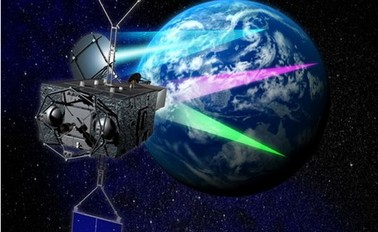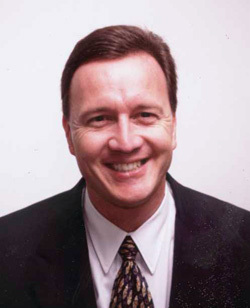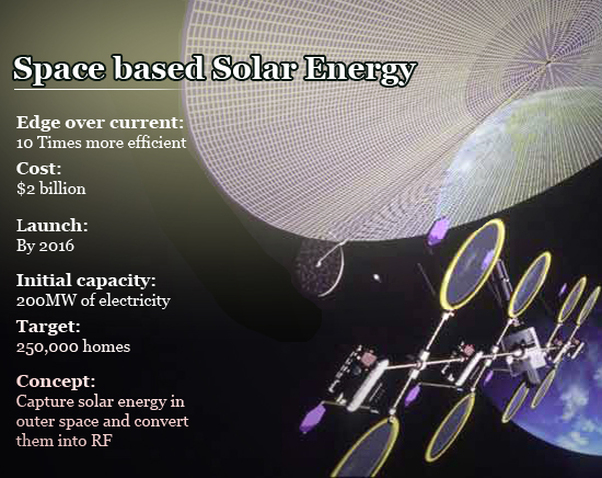 A new Californian startup, Solaren, claims to have committed to deliver 200 MW power from the Space, beamed down to the Earth by 2016. In the interview CEO of Solaren Gary Spirnak revealed : "This will be the world's first SSP plant. While a system of this scale and exact configuration has not been built, the underlying technology is very mature and is based on communications satellite technology. " For over 45 years, satellites have collected solar energy in earth orbit via solar cells, and converted it to radio frequency (RF) energy for transmissions to earth receive stations. This is the same energy conversion process Solaren uses for its SSP plant. Interestingly enough that the Solaren website remains very scarce on the information about the company. Except for the flashing logo and contact email address there is nothing to see. I would think this page belongs to geocities free websites rather than leading to the brightest rocket science entrepreneurs. Space Based Space Solar energy concept isn't exactly very new. It first originated as an idea in 1968 and later patented by Dr. Peter Glaser, Space‐Based Solar Power captures sunlight on orbit where it is constant and stronger than on Earth, and converts it into coherent radiation that is beamed down to a receiver on Earth. The studies remained classified for most of 20-th century,though in 2007 a public group Space Frontier Foundation was established with the presence on the web. According to the website, Space Frontier Foundation submitted a white paper on Space-Based Solar Power to the Obama transition team in the December of 2008 even before Obama's presidential inauguration. Although business commitment to PG&E sounds serious, the technical challenges to achieve this goal are more substantial than those in building International Space Station. And let me recall that just a month ago we were witnessing an embarrassing episode during the test of space station urine-recycler. Lead spacewalk officer Glenda Laws-Brown told after the incident: "As you know, when you get to the International Space Station there is no up and down. And my guess is they thought they had it in the right configuration, but because up is down and down is up, it was actually 180 degrees out from where it should have have been" The mundane task was just loosening six bolts holding a set of batteries in place whereas assembling Solaren's Solar Plane should be a task much bigger than only 6 bolts. Whether Solaren will be more successful than NASA or they will become the target of Google's takeover towards alleged Moon-based internet station in 2016 only time will tell.  Solaren CEO Gary Spirnak Interview with Solaren CEO Gary Spirnak: NEXT100 asked Solaren CEO Gary Spirnak to offer his perspective on the business strategy and technological approach behind his company's contract to deliver 200 MW of baseload space solar power to PG&E's customers by 2016. Here are his answers: Q: What is Solaren Corporation? A: Solaren is a California C Corporation that formed in 2001 and is based in Manhattan Beach, CA. Solaren was formed by a team of satellite engineers and space scientists to build a space energy company to generate and distribute electricity at competitive prices from Space Solar Power (SSP) stations in geosynchronous orbit. Solaren currently consists of about ten engineers and scientists, but plans to grow to more than 100 over the next twelve months. Q: What was the impetus for forming the company? A: The impetus for forming Solaren was the convergence of improved high efficiency energy conversion devices, heavy launch vehicle developments, and a revolutionary Solaren-patented SSP plant design that is a significant departure from past efforts and makes SSP not only technically, but economically viable. Q: What kind of experience does your team have? A: Each Solaren team member each has 20 to 45 years experience in the aerospace industry, primarily with Hughes Aircraft Company and the US Air Force, and has successfully developed and managed many first-of-a-kind, innovative space projects. Q: Has anything like this been built before? A: This will be the world's first SSP plant. While a system of this scale and exact configuration has not been built, the underlying technology is very mature and is based on communications satellite technology. For over 45 years, satellites have collected solar energy in earth orbit via solar cells, and converted it to radio frequency (RF) energy for transmissions to earth receive stations. This is the same energy conversion process Solaren uses for its SSP plant. Q: What gives you the confidence that you can design the system? A: The SSP pilot plant system design will work hand and glove with an extensive Solaren engineering development program. Before the Solaren SSP plant is constructed, an engineering development program will be implemented to reduce the cost, schedule and engineering risk associated with the Solaren SSP pilot project. The engineering development program is a meticulous step-by-step process that will validate all SSP components, subsystems and systems. In addition to laboratory and ground tests, Solaren plans to test and evaluate critical SSP system deployments and functionality in space. The rigorous SSP pilot plant design will be created from the foundation of engineering data generated through the SSP development program's component, subsystem and system tests. Q: What gives you confidence that you can launch this system into space? A: The SSP pilot plant satellites are designed to use existing launch capabilities. No new space launch vehicle capabilities need to be developed to launch our satellites into space. The SSP pilot plant design for the power satellites and ground receive station will be built and validated and the power satellites prepared for shipment to the launch site during the construction phase. At the launch site, the power satellites are launched into space using existing launch vehicle capabilities and moved to their final orbital positions. Q: Finally, what gives you the confidence that you can start generating power by 2016? A: What gives us the confidence that we can start generating power in 2016 is the experience of Solaren's team and suppliers, and these five steps. First, our meticulous SSP engineering development program will reduce program risk. Second, our rigorous SSP Pilot plant design will ensure that we meet or exceed our SSP system performance requirements and that the design is buildable. Third, the construction of the SSP Pilot plant is built to exacting specifications, which are each verified and validated. Fourth, the SSP satellites undergo a final verification prior to launch, and use low risk, existing launch vehicle capabilities for delivery to space. Fifth, once in geosynchronous orbit, a series of SSP pilot plant system tests will validate the satellites and ground receive station functions and verify performance, safety and key parameters to ensure successful operations. When we complete these steps, we will then be ready to deliver power to PG&E in 2016. Q: Does Solaren have the option to not deliver power? Is this a best-effort contract? A: No. We are required under this PPA to deliver the contracted 200 MW of baseload power on the contracted start date to PG&E, and Solaren is committed to making that date. Q: Why go this route instead of sticking with more familiar terrestrial solar technology? A: Solaren's patented design and proprietary approaches result in a baseload power generation system that is competitive both in terms of performance and cost with other sources of baseload power generation. We believe terrestrial solar power will play an increasing role in satisfying peak electricity demand. Solaren SSP is fundamentally different from terrestrial solar in that we address baseload power not peaking power. Q: How does your SSP pilot plant work? A: Solaren's patented SSP plant design uses satellites in Earth orbit to collect solar energy in space and generate power, which is transmitted to the ground receive station for conversion to electricity for delivery to PG&E. Specifically Solaren's SSP satellites use solar cells in space to convert the sun's energy to electricity. This electricity powers high efficiency generator devices, known as solid state power amplifiers (SSPA). The SSPA devices on-board the satellite convert electricity into RF energy. Next the SSP satellite, using the RF energy and the satellite's antenna, directs and transmits the RF power to the California ground receive station. The ground receiver directly converts the RF energy to electricity, and uses the local power grid for transmission to the PG&E delivery point. Q: What is the potential of Space Solar Power? A: Collecting solar energy in space and transmitting it to earth offers a significant untapped energy resource. The sun's energy is almost continuously available to a satellite located in a GEO orbit about the earth. According to an October, 2007 US Department of Defense (DOD) National Space Security Office (NSSO) study which included representatives from DOE/NREL, DARPA, Boeing and Lockheed-Martin: "A single kilometer wide band of geosynchronous earth orbit experiences enough solar flux in one year (approximately 212 terawatt-years) to nearly equal the amount of energy contained within all known recoverable conventional oil reserves on Earth today (approximately 250 TW-yrs)." Q: Is the renewable energy generated from this project completely carbon-free? A: Yes. Solaren's SSP energy conversion process is completely carbon-free. Q: How will this project impact the environment? A: The construction and operations of Solaren's SSP plant will have minimal impacts to the environment. The construction of the SSP ground receive station will have no more environmental impact than the construction of a similarly sized terrestrial photovoltaic (PV) solar power plant. Space launch vehicles will place the SSP satellites into their proper orbit. These space launch vehicles primarily use natural fuels (H2, O2) and have an emissions profile similar to a fuel cell. When in operation, the Solaren SSP plant has a zero carbon, mercury or sulfur footprint. In addition, the high efficiency conversion of RF energy to electricity at the SSP Ground Receive Station does not require water for thermal cooling or power generation, unlike other sources of baseload power (nuclear, coal, hydro). Q: How was the SSP ground receive station site selected? A: We had three major requirements for the selection of the SSP ground receive station. First, was the selection of a site that is close to a large load center, second the site had to be a short distance from a PG&E substation, and third was not to use any long distance transmission lines. Q: When will Solaren be able to provide more details about your SSP pilot plant project? A: We are currently supporting the CPUC regulatory filing process, and plan to provide additional details about our SSP pilot plant project in early Summer 2009.
0 Comments
Your comment will be posted after it is approved.
Leave a Reply. |
News Watch
Mind-opening news articles, editorials, videos & apparel that inspire our readers and help liberate them from the status quo. Stay informed.
Write For UsSpace WatchTop NewsNews Watch Categories
All
|
|
|
HAVE A TIP OR STORY TO TELL? JOIN TODAY & SHARE YOUR STORY!
If you have a breaking news tip or idea, please email: [email protected] Apparently Apparel® is a registered trade name and part of the ZOAT International® brands network. © 2007-2023. All Rights Reserved. Privacy Policy. All art & news content posted on this site is commentary or opinion and is protected under Free Speech. ApparentlyApparel.com is not responsible for content written by contributing artists, authors or news feeds. The information on this site is provided for educational and entertainment purposes only. It is not intended as a substitute for professional advice of any kind. ApparentlyApparel.com assumes no responsibility for the use or misuse of this material.
|
|








